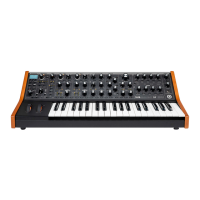22
MODULATION
Controlling modulation (abbreviated as MOD) is an important
aspect of programming and playing synthesizers. When
you modulate a synthesizer’s audio signal, you are changing
something about the way it sounds. When you modulate a control
signal, you are changing something about its effect on whatever
it’s controlling. Synthesizers route their control signals from
modulation sources to modulation destinations. On the Sub 37, a
changing control signal can modulate pitch, filter cutoff, waveform
shape, VCA level, LFO rate, noise level, EG time, and a variety of
additional destinations available via the PRESET EDIT MENU.
The Sub 37 has two modulation busses labeled MOD 1 and MOD 2.
They are nearly identical except that, by default, the overall depth
of MOD 1 is determined by the MODULATION wheel. You can
access and edit this, and other extended modulation parameters by
pressing the CONTROLLERS button.
Low-frequency oscillators generate repeating waveforms in the sub-
audio frequency range. The Sub 37’s LFOs also have a HI RANGE
button, which allows the LFOs to generate frequencies well into
the audio range as well. At sub-audio rates, the LFOs are useful for
generating repeating effects. At audio rates, the LFOs add harmonic
complexity to their destinations.
When an LFO modulates an oscillator’s frequency, the oscillator’s
pitch follows the shape of the modulating waveform. If the LFO’s
output is a triangle wave, the pitch rises and falls at a regular
rate. At the proper rate and depth, this type of modulation is called vibrato. Many performers rely on
vibrato to add expression to their performances. A violinist or guitarist employs vibrato with a shaking
motion of the hand as it applies pressure to the string. A singer subtly fluctuates their vocal pitch. A
synthesist uses an LFO to modulate an oscillator’s frequency. The LFO RATE knob controls the rate of
modulation, and the MODULATION wheel controls its depth.
MODULATION CONTROLS
LFO RATE
By default, the LFO RATE knob varies the low-frequency oscillator’s modulation rate from 0.1Hz (one cycle
every 10 seconds) to 100Hz (100 cycles per second). This can be multiplied 10x by using the HI RANGE button.
SOURCE
Use this knob to specify whether the modulation source is one of 5 LFO waveforms, the filter envelope,
or a programmed source. At its most counterclockwise position, the LFO generates a triangle wave,
which is particularly useful for vibrato. Turning the knob clockwise, the next position generates a
square wave, which is useful for performing trills and tremolo effects. The next two positions generate
sawtooth and ramp (reverse sawtooth) waves. Applied to pitch, sawtooth-wave modulation is useful
for simulating alarms, ray guns, and other ascending and descending effects.The fifth position uses
sample-and-hold as a modulation source. Think of sample-and-hold as a source of random control
signals. (Think 1970’s Hollywood sound effects of a computer “thinking”.)
When SOURCE is set to F. EG/PGM, the LFO is bypassed and by default, the filter’s envelope settings
are used as a source of modulation. A variety of additional modulation sources are also available to
you by pressing the CONTROLLERS button. To learn more about the MOD CONTROLLERS menu, go
to page 50.

